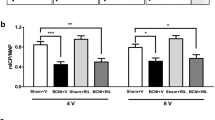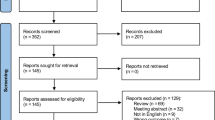Abstract
The preservation of NANC nerve fibers (producing nitric oxide, NO) is necessary for erection recovery after retropubic radical prostatectomy (RRP). Yet, it is impossible to establish when and if a patient will recover erections; therefore, we investigate the prognostic value of cavernous blood NO levels on this parameter. Nerve-sparing RRP was performed on 14 patients for localized prostate cancer. We evaluated all patients 3 months after surgery by IIEF score: no patients had erections. A cavernous blood sample was also taken to determine NO levels (as nitrite). Patients were evaluated again 18 months after surgery. In six cases, erectile function was compromised, whereas in seven cases, potency was restored. Statistical analysis showed a relationship between nitrite levels in cavernous blood 3 months after surgery and the recovery or erectile function at 18 months. We propose that cavernous NO blood levels are a prognostic index of erection recovery.
This is a preview of subscription content, access via your institution
Access options
Subscribe to this journal
Receive 8 print issues and online access
$259.00 per year
only $32.38 per issue
Buy this article
- Purchase on Springer Link
- Instant access to full article PDF
Prices may be subject to local taxes which are calculated during checkout

Similar content being viewed by others
References
Walsh PC, Epstein JI, Lowe FC . Potency following radical prostatectomy with wide unilateral excision of the neurovascular bundle. J Urol 1987; 138: 823–827.
Catalona WJ, Basler JW . Return of erections and urinary continence following nerve sparing radical retropubic prostatectomy. J Urol 1993; 150: 905–907.
Montorsi F, Briganti A, Salonia A, Rigatti P, Burnett AL . Current and future strategies for preventing and managing erectile dysfunction following radical prostatectomy. Eur Urol 2004; 45: 123–133.
Carrier S, Zvara P, Nunes L, Kour NW, Rehman J, Lue TF . Regeneration of nitric oxide synthase-containing nerves after cavernous nerve neurotomy in the rat. J Urol 1995; 153: 1722–1727.
Podlasek CA, Gonzalez CM, Zelner DJ, Jiang HB, McKenna KE, McVary KT . Analysis of NOS isoform changes in a post radical prostatectomy model of erectile dysfunction. Int J Impot Res 2001; 13 (Suppl 5): S1–S15.
Gonzalez-Cadavid NF, Rajfer J . Molecular pathophysiology and gene therapy of aging-related erectile dysfunction. Exp Gerontol 2004; 39: 1705–1712.
Kim N, Azadzoi KM, Goldstein I, Saenz dTI . A nitric oxide-like factor mediates nonadrenergic-noncholinergic neurogenic relaxation of penile corpus cavernosum smooth muscle. J Clin Invest 1991; 88: 112–118.
Bush PA, Aronson WJ, Buga GM, Rajfer J, Ignarro LJ . Nitric oxide is a potent relaxant of human and rabbit corpus cavernosum. J Urol 1992; 147: 1650–1655.
Azadzoi KM, Kim N, Brown ML, Goldstein I, Cohen RA, Saenz dT . Endothelium-derived nitric oxide and cyclooxygenase products modulate corpus cavernosum smooth muscle tone. J Urol 1992; 147: 220–225.
Burnett AL . Nitric oxide in the penis: physiology and pathology. J Urol 1997; 157: 320–324.
Burnett AL . Novel nitric oxide signaling mechanisms regulate the erectile response. Int J Impot Res 2004; 16 (Suppl 1): S15–S19.
Rosen RC, Riley A, Wagner G, Osterloh IH, Kirkpatrick J, Mishra A . The international index of erectile function (IIEF): a multidimensional scale for assessment of erectile dysfunction. Urology 1997; 49: 822–830.
Palmerini CA, Arienti G, Palombari R . Nitrosothiols and S-nitrosohemoglobin. Methods Enzymol 2002; 359: 229–237.
Ignarro LJ, Fukuto JM, Griscavage JM, Rogers NE, Byrns RE . Oxidation of nitric oxide in aqueous solution to nitrite but not nitrate: comparison with enzymatically formed nitric oxide from L-arginine. Proc Natl Acad Sci USA 1993; 90: 8103–8107.
Knowles RG, Moncada S . Nitric oxide synthases in mammals. Biochem J 1994; 298 (Part 2): 249–258.
Moriel EZ, Gonzalez-Cadavid N, Ignarro LJ, Byrns R, Rajfer J . Levels of nitric oxide metabolites do not increase during penile erection. Urology 1993; 42: 551–553.
Author information
Authors and Affiliations
Corresponding author
Rights and permissions
About this article
Cite this article
Zucchi, A., Arienti, G., Mearini, L. et al. Recovery of sexual function after nerve-sparing radical retropubic prostatectomy: is cavernous nitric oxide level a prognostic index?. Int J Impot Res 18, 198–200 (2006). https://doi.org/10.1038/sj.ijir.3901392
Received:
Revised:
Accepted:
Published:
Issue Date:
DOI: https://doi.org/10.1038/sj.ijir.3901392



